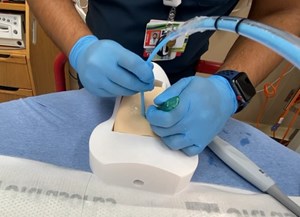
The New Frontiers of Ultrasound
Fred Milgrim, MD, Matthew Riscinti, MD
Denver Health Department of Emergency Medicine
Over the past two decades, point-of-care-ultrasound (POCUS) has undergone two primary revolutions. First, its widespread adoption has led to the deliberate development of POCUS curricula in residency education, furthering its use as newer grads enter the workforce—only reinforcing greater adoption. Second, and arguably more exciting, are the technological advances that have drastically reduced the footprints and costs of our machines leading to increased scalability and ease of access in global health, low resource, and otherwise remote environments. Despite this apparent revolution, POCUS’ widespread deployment remains plagued by one central problem, operator dependence. We believe that the third revolution is underway: the marriage of Artificial Intelligence (AI) and POCUS. Not only does it have the potential to eliminate operator dependence, it allows us as POCUS educators to exponentially scale our impact.
With the introduction of AI in ultrasound, both the novice and skilled operator will have the opportunity to receive real time feedback from the machine when scanning. One current possibility is via image quality indicators that change as the operator slides the probe toward, or away from the target organ. In some cases, this can also include directions for how to manipulate the probe and obtain an appropriate view. A slightly more basic concept, but arguably even more beneficial, is the introduction of anatomical labeling tools, where the machine recognizes and labels both normal and abnormal anatomy in real time. With these tools alone, it’s easy to see how AI is eliminating operator dependence by assisting with image acquisition and also potentially picking up pathology for the untrained eye.
While prehospital and global health seem like the obvious next frontier, AI assisted handheld devices will be most critical for military and future space missions. Teleguidance is still possible for earthly ultrasound, but when manned missions to Mars take place, it will be impossible for a physician using teleguidance to direct an astronaut how to acquire an image and diagnose anything. The videos and images simply take too long to transmit—as long as 44 minutes each way—not to mention the cost and radiation exposure of utilizing X-ray or CT modalities in settings already greatly affected by radiation and size constraints. This is where portable ultrasounds equipped with AI come into play. They are tiny, lightweight, and closed circuit. AI algorithms do not depend on a communication link. Our work is showing that inexperienced STEM students, many of whom intend to be astronaut candidates one day, can consistently obtain accurate bladder ultrasound images with the assistance of AI, and such applications will only continue to grow. POCUS will undoubtedly be the imaging modality for prolonged space flight and AI will help our astronauts maintain their skills and diagnostic abilities.
All of these innovations have, and will, succeed in making POCUS accessible to all levels of front-line and EM providers (and astronauts). Meanwhile, those pushing the field forward with advanced applications of POCUS are likely to start seeing those tools more widely distributed to the average recent grad—those adept in image acquisition, but still unaware of all the questions that can be answered at the bedside. Some of these tools already exist, such as AI derived analysis of cardiac output using left ventricular outflow tract velocity time integral (LVOT VTI), but there are so many possibilities, such as analyzing fluid status with VExUS and diving into all the possibilities using advanced doppler. We are still exploring which questions are worth asking next!
The acceleration of POCUS technology has been astounding of late, and it will only continue to launch us, and the entire house of medicine, forward.



